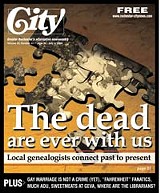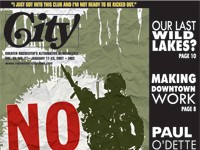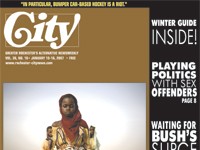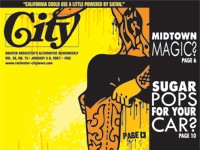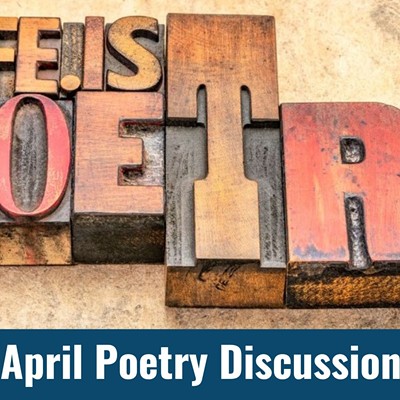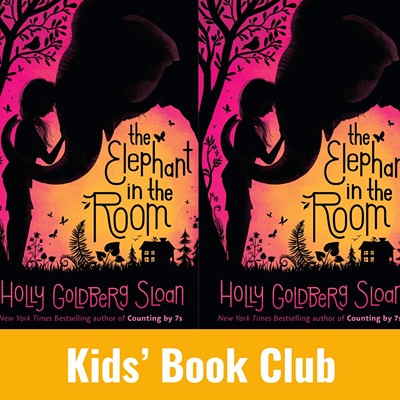[
{
"name": "500x250 Ad",
"insertPoint": "5",
"component": "15667920",
"parentWrapperClass": "",
"requiredCountToDisplay": "1"
}
]
Most of the time, the living leave the dead alone. We might take a walk in a beautiful cemetery such as Mt. Hope. Or we might wave a little flag on Memorial Day. Elvis imitators resurrect The King for fun and profit. At a Spiritualist church you might find the dead speaking through a glassy eyed medium. And we pass countless pictures of dead presidents back and forth all day.
But there's a smaller slice of the population who have a different relationship with the dead. They want knowledge, understanding, truth.
And so they go digging in paper graveyards. Death certificates, census reports, cemetery records, city directories, wills, and newspaper birth announcements. Here, a trace of the truth can be found.
"As long as there's more information out there, I'll keep working," says Richard Squires. "I love research. Every little thing I find, that's the payoff. That's the reward."
Squires, a librarian at Monroe Community College, has spent endless hours doing genealogical research. What's interesting about his work, however, is that he's focused on someone else's family. His book, Stern Fathers Under the Mould, is an in-depth study of the Lovecraft family in Rochester.
H.P. Lovecraft was one of America's most important horror writers. His Chthulhu Mythos stories have spawned endless imitations, movies, websites, cultic devotion, and scholarly researches. But until Squires had done his work, there was no solid study of Lovecraft's ancestors in Rochester.
Squires was a fan of Lovecraft and his tales of madness and ancient dread. But he also saw real value in uncovering facts about more ordinary people. "As I began to uncover the bits and pieces of data, a feeling of resentment stirred within me," he says. "I was beginning to resent the way in which HPL had trivialized these Rochester Lovecrafts."
Though ordinary folks, they experienced real drama and significance in the everyday workings of their lives.
"I used to think of it as a puzzle," Squires says. "But a puzzle is completed. A painting might never be finished. It's one more brush stroke on the canvas. Now we have a picture we can look at. Every little piece is another brush stroke."
In the course of his research, Squires met with many people who had only a passing understanding that a member of their family had such legendary status.
"I was amazed at their openness," Squires says. "They opened up family stories for me. They showed me marriage certificates, photo albums, and a family Bible.
"What I wanted to do was to piece together a social history of the family, to make each name on the genealogical charts connect with a once-living and breathing entity," he says. "I wanted to put some flesh on the bones."
The largest genealogical archive on the planet is maintained by The Latter Days Saints, more commonly known as the Mormon Church. The collection in Salt Lake City contains more than a billion rolls of microfilm, almost a million microfiches, and 300,000 books and serials. There are also smaller archives around the country, two in Monroe County.
Betty Hales, director the Brockport Family History Center, explains why the LDS church has for over 100 years researched millions of genealogical records: "We've learned through revelation that we can be together forever," she says. "We do family history because we believe that families can be together forever. A man and woman can be married for time and all eternity."
Hales, whose mother never joined the LDS Church on earth, has been bonded to her family in a postmortem ritual called a "sealing."
"My daughter-in-law in Australia was baptized in proxy for my mother," she says. "Kind of like when you buy a house, the real-estate agent stands in proxy for you at the legal proceedings."
But this ritual does not guarantee Hale's mother a place in the Celestial Kingdom. "Baptism is the door, the entry," she says. People still might refuse to join their families in the next world. "They have the choice on the other side."
But these ancestors can only be "sealed" to the body of believers if they are identified by name. In the next world, Hales says, the dead will have another chance to join the Mormon church. "I picture the afterlife as a place where you can be together sharing what you know, basically being missionaries, teaching those who've died."
"God will create a place for us where we'll dwell with Him," says Paul Toner, director of the LDS Family History Center on Westfall Road. "A literal place, a perfected world. Individuals will look like Him, have His powers and attributes, but still be subject to Him."
This interplanetary aspect of LDS belief is not talked about much, but it's essential to Mormon notions of the afterlife. The Prophet Joseph Smith has revealed to Mormons that if you went looking for God, you'd best start with the Planet Kolob, which is, according to Toner, "the planet nearest to where God dwells. It's the first world which God created."
God's nature also differs in Mormon belief from Christian theology. "God has a glorified body," Toner says. "Not flesh and blood, but flesh and pure light. He has a perfected body that can not die because it has no blood." Unlike the nebulous, ethereal idea of God that many folks hold, the LDS church is adamant that God, in Toner's words, "was once a man who dwelled on an earth like this one." But he progressed in an upward direction, becoming "perfected," as individual Mormons on this earth can also.
This is not some obscure teaching, but central to Mormon belief. Understanding your place in family history is crucial to establishing your place in the afterlife. In the church's own Journal of Discourses, the Prophet Joseph Smith is quoted as saying, "You have got to learn how to be Gods yourself... the same as all Gods have done before you." And the church's top leader, Spencer W. Kimball, declared that the faithful "may become gods. There seems to be plenty of space out there in the universe."
Toner says there are "worlds without number. God's purpose is to create worlds. He's still in that process. And always will be." There's a real optimism in LDS belief, a sense that progress is real, in this world and the next. And for Mormons who make the right choices, ruling a planet as God does here is a good possibility. "You can be whatever you want to be." In the Celestial Kingdom "everyone will be totally and individually free."
A 4-year-old girl named Janet Mercel died in 1929. She was my grandparents' first daughter. And though her life was short, she casts a long shadow over my family. Digging ore from my own genealogical mother lode, finding and reading Janet's death certificate, has helped me understand who I am and where I came from.
I own two photos of Janet. In one she looks back at the camera beautifully alive though not a beautiful child. Big green eyes like her sister (my mother), short cropped hair, pudgy hands, a wisp of a smile. There's inquiry in her eyes, a childish questioning. She was speaking by then, age four, listening, sitting in church and hearing the hymns. She asks a question, or perhaps I ask it for her, singing these words I found in my grandparents' Methodist hymnal:
And am I born to die, to lay this body down
And must my trembling spirit fly, into a world unknown?
The other picture of Janet is from her wake, a few months later. It shows a small white coffin in the living room on May Street, near Mt. Hope Cemetery. Mountains of roses and lilies, baskets and wreathes and vases. The entire foreground, the floor, and every horizontal surface is filled with flowers. Behind the coffin a small palm tree arches. Janet's face, rigid in death, is hard to find in the hothouse profusion. It's the same face as the other photo, the same pudgy little hands, but stiff and waxy like carved soap. A 4-year-old dead because the doctor could do nothing to treat meningitis. No sulfa antibiotics, no penicillin.
So my mother was born only a year later, a replacement for Janet, and was, according to my grandfather, "the most wanted child in the world."
That little dead girl now reaches her hand out seven decades later and holds me by the throat. Her illness, her death, transformed my mother's family. Fear of disease loomed over the Mercel household. The world became, in the course of a week, a place of unseen danger. Meningitis consumes the body in days. One Sunday, your little girl is playing in the lawn and the next she's lost, laid deep in coffin earth.
Similarly, my paternal grandfather was killed by pneumonia, before there was effective treatment for it. Agents of disease, viruses, and bacteria haunt my past. Infections loom like ghosts, ready to drag us to the next world.
And when I add the facts of Janet's death to the image of her father (a few short months after the stock market crash) going door to door around Rochester, looking desperately for any kind of work, a picture emerges that helps explain a great deal about my own character.
I grew up knowing that the world was not a safe place. Fear loomed from the past. Malign forces hovered just out of sight. And this genealogical fact, not uncovered until I was in my 40s, has helped me make sense of who I am, and why.
There's no one left who knew Janet in the flesh. I take care of her grave in Mount Hope. I hold the photos. Even to me, though, she's a phantom.
Michael Meggison has also spent much time working his way backward through his family's history. No deep secrets have been revealed. There's been no great transformation in how he understands himself or his background. Still, for the last two decades, genealogy has been one of his great passions. And for the last two years, it has been part of his professional life as well.
As a child, he moved with his immediate family from Long Island to Livonia. Cut off from his grandparents, cousins, aunts, and uncles, he felt isolated in his new home. "I was envious," he says, of the people around him who had close connections to their extended families. "I was without any kin to call my own. Once we moved here, we cut off all ties, although it was not intentional."
He began working on his family's history at age 18, as "a way to connect with family I had not seen or even heard of." Describing the fascination genealogical research has for him, Meggison excitedly talks about "lineals and collaterals," strangers sharing personal stories, "living blood," and the way certain professions are passed down through the generations.
He spent years on this project, finally in 2000 publishing a well-regarded book on the Meggison family called MEGGISON: The Ancestors and Descendants of Capt. George Eden Meggison (1756-1815).
Since then, he's branched out into other major genealogical projects with a Rochester focus. One of them concerns the ancestors of George W. Bush. Three generations of this dynasty lived in our area. When asked why a politician's distant ancestors are significant, Meggison explains, "The Bush family was pretty nomadic. More generations of the family situated in this area than any other place they lived." George W's great-great-great-grandfather Timothy lived on King Street, and his descendants occupied the still-standing house until 1959. In fact, some of George W's ancestors are buried near here. Timothy Bush's grave can be found in Oakfield Cemetery in Penfield.
Meggison talks about "civic pride," when explaining his interest in genealogy. But it seems that something deeper than Rochester boosterism is at work. Creating his own family tree was like having a "big family reunion. All these ancestors were there in spirit, if not in person." There's a real satisfaction in mastering mountains of facts, linking the generations, making sense of seemingly random data.
Meggison admits that his research "took a lot of my social life." Though it sometimes is a family project, usually genealogy "can be pretty solitary." When he was younger, he kept his fascinations pretty well under wraps. "Genealogy is often associated with old ladies and eccentrics."
Now in this 30s, Meggison has "come out," as he puts it. Beside his day job at Paychex, he now performs genealogical work as a professional, doing the fine-grain research necessary to connect people with their pasts. "It's like discovering uranium every time I find the link they were looking for."
Yes, the living often seem more important than the dead. But the links between past and present, those who've gone before and those still here, are far more significant than we usually admit. Or, as Meggison puts it, "There's more than just us."
Speaking of...
-

The City Seen: October 16-20
Oct 21, 2015 -

Wooly bully
Jul 1, 2015 -
News briefs 8.14.02
Aug 14, 2002 - More »
Latest in Featured story
More by Th. Metzger
-
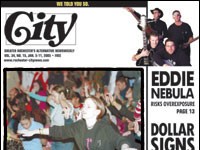
Power and passion
Jan 5, 2005 -
Tales of the mundane
Nov 3, 2004 -

Gathering home the harvest
Apr 28, 2004 - More »
